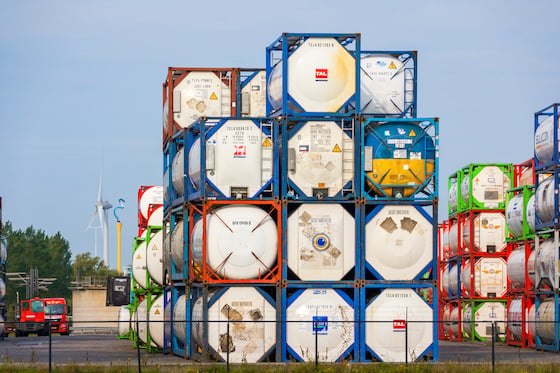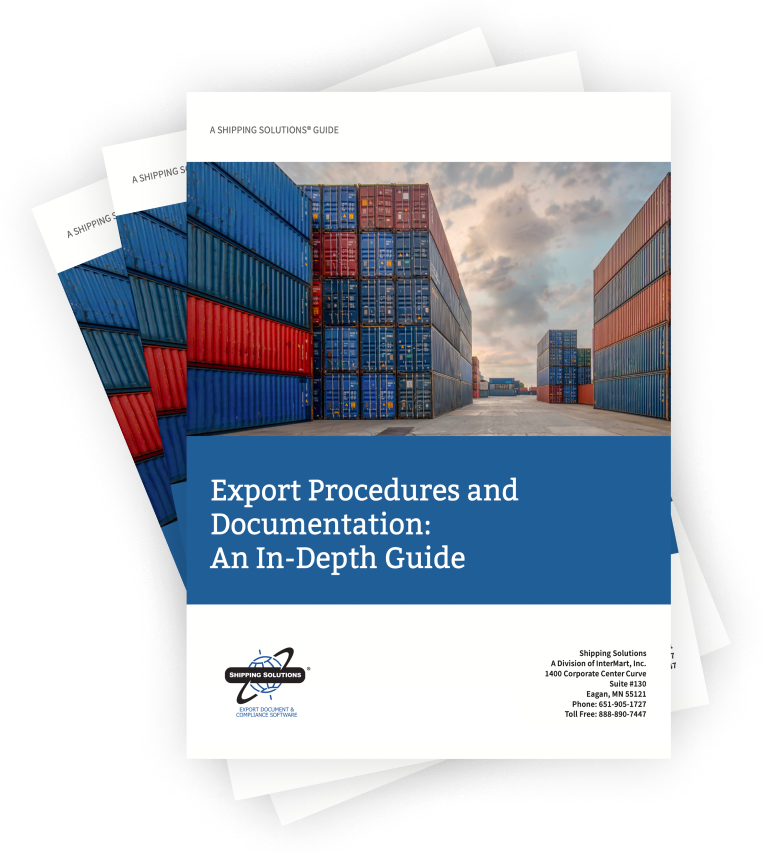The International Trade Blog Export Compliance
The Ins and Outs of Exporting Liquids in Bulk: ISO Tanks
On: September 25, 2023 | By:  Sean Whitworth |
6 min. read
Sean Whitworth |
6 min. read
 Welcome to the second article in our series on the transport of liquid. In a world where most of us are familiar with exporting freight that comes in various sizes of boxes, liquids present a different set of challenges for transportation and positioning in the supply chain. Last time we looked at the intermediate bulk container (IBC) tote. This time we are going to look at shipping liquid in larger quantities using the ISO tank. Depending on the nature of your business, it may make more sense to ship in bulk to gain economies of scale. ISO tanks can carry more volume per container than other forms of liquid transport, and this results in less cost per unit of product. According to ITCO, the demand for ISO tanks is rising. The January 2023 fleet was recorded at 801,800 units, which was a year-on-year growth of 8.65%. The United States is a top 3 exporter of ISO tanks.
Welcome to the second article in our series on the transport of liquid. In a world where most of us are familiar with exporting freight that comes in various sizes of boxes, liquids present a different set of challenges for transportation and positioning in the supply chain. Last time we looked at the intermediate bulk container (IBC) tote. This time we are going to look at shipping liquid in larger quantities using the ISO tank. Depending on the nature of your business, it may make more sense to ship in bulk to gain economies of scale. ISO tanks can carry more volume per container than other forms of liquid transport, and this results in less cost per unit of product. According to ITCO, the demand for ISO tanks is rising. The January 2023 fleet was recorded at 801,800 units, which was a year-on-year growth of 8.65%. The United States is a top 3 exporter of ISO tanks.
What Is an ISO Tank?
An ISO tank is a tank container that’s designed specifically to carry liquids (and many gases and powders) in bulk. The ISO designation comes from the International Organization for Standardization, which creates the standards that tanks must conform to in order to ship by different modes of transportation.
They are made primarily of insulated stainless steel and have an outer protective layer of aluminum and polyurethane. All ISO tanks will have an outer cage that allows them to be more easily handled, stacked and transported. ISO tanks are identified in a similar way to regular dry containers. Each ISO tank will have a BIC code comprised of a three-letter owner/operator code, a fourth letter used as an equipment identifier, a serial number of six Arabic numerals and a seventh digit which acts as a check digit. It will also have a size and type code.
What Are the Most Common Standard Sizes and Types of ISO Tanks?
ISO tanks come in 20-foot, 40-foot and 45-foot sizes with the cage in place to facilitate easy transport between truck, rail and ocean modes.
Capacity, Weight and Specific Gravity
ISO tanks will range in capacity between 17,500 to 26,000 liters (5,300 to 6,600 gallons). The maximum payload weight of an ISO tank depends on several factors, such as the size and type of the tank, the tare weight of the tank, the cargo weight and volume, and the truck weight regulations in each state. According to one source, the maximum gross weight of an ISO tank is 36,000 kilograms (79,365 pounds), which includes the tare weight (empty tank) and the payload weight. However, this does not include the weight of the truck used to drive the trailer from your facility to the port for export. According to 23 CFR 658.17, the maximum gross vehicle weight in the U.S. is 80,000 pounds without permits. A typical max payload weight for a 20-foot ISO tank traveling by truck would be approximately 44,000 pounds to allow for the weight of the truck and trailer to “scale out” at less than 80,000 pounds.
Another important consideration is that according to ITCO, ISO tanks should be at least 80% full to prevent a surge of the liquid, which can be a potential hazard for handling and transport. ISO tanks should also be always less than 95% full to allow for thermal expansion.
When working with liquid exports using ISO tanks, it’s also very important to know the specific gravity of the liquid you are shipping. Specific gravity refers to the ratio of the density of a material compared to the density of water. The higher the specific gravity, the denser the liquid will be and thus heavier. CLX Logistics provides a formula guide for calculating how much volume is needed for different tank sizes to meet the 80% fill requirement. Different specific gravity ratios will necessitate different tank container sizes. Some products will require specific container sizes to meet the 80% to 95% fill requirement.
What Are Some Examples of the Kinds of Products That Can Be Shipped in ISO Tanks?
ISO tanks can ship a variety of products from food products to hazardous and non-hazardous chemicals. Note that even though ISO tanks are reusable after washing, only food-grade ISO tanks may ship food products and an ISO tank that has been used to ship chemicals or fuel will never be used to transport a food product. Here are some commonly shipped materials:
- Food: milk, alcohol, cooking oils, molasses, grains
- Fuel: diesel, gasoline, compressed natural gas
- Chemicals: sulfuric and nitric acid, solvents like acetone and toluene, hydrogen peroxide
- Industrial oils: coolants, cutting oils, wire lubricant
- Crop science: pesticides, herbicides, inerts, fertilizers
What to Look Out for When Shipping ISO Tanks?
Leaks and Spills
ISO tank containers are designed and engineered to minimize the risk of spills and leaks. However, leaks can develop due to factors such as corrosion, cracking, damage from forklifts and reach stackers, and defective seals. It’s important to have ISO tanks inspected regularly for safety.
High-Temperature Liquids
Some liquids will require that tanks be heated otherwise the liquids could solidify. There are three different ways to heat an ISO tank. Steam and hot water (before unloading), and in-transit heating where the product must be maintained at a specific temperature during the entire trip by specially equipped tanks.
Tanker Endorsement
Drivers will need to have a tanker endorsement on their commercial driver’s license (CDL). This is required in the U.S. by the Federal Motor Carrier Safety Administration (FMCSA) for any shipment where:
- Filled cargo includes individual containers of 119 gallons or more.
- The total combined volume of liquid (or gas) is greater than 1,000 gallons.
What Are the Advantages of an ISO Tank?
- Caged ISO tank containers are uniform and easy to handle and transfer to different modes of transport.
- ISO tanks can be reused many times and can stay in service for up to 20 years depending on the type of cargo they carry.
- Versatility: Many products can be carried, including hazardous materials and international maritime dangerous goods (IMDG).
- They’re cost-effective, gaining economies of scale.
- Environmentally friendly: ISO tanks reduce the need to handle and transload. They are designed to be leak-resistant. Versus IBC totes, ISO tanks have fewer components that can fail and cause leaking.
Any Disadvantages?
- Cleaning costs.
- Container positioning: Tank containers must be moved back to the shipping origin or another location where they are needed by the suppliers. Tank positioning can add to the overall cost of use.
- Costly to produce and repair.
Conclusion
ISO tanks can be a great solution for exporting your liquid products. It’s worth taking some time to get familiar with these different types of liquid containers and compare the qualities of each to optimize your liquid logistics. In the next article in the series, we’ll be looking at the flexibag (flexible tanks) and its niche in the liquid transport market!
Like what you read? Join thousands of exporters and importers who subscribe to Passages: The International Trade Blog. You'll get the latest news and tips for exporters and importers delivered right to your inbox.

About the Author: Sean Whitworth
Sean Whitworth is a trusted international trade expert for a number of shippers and manufacturers. He currently works in the 3PL space serving clients in a broad range of industries including energy, automotive glass and plastics, textiles, forestry products and more. He has worked as a consultant for importers/exporters assisting with everything from preparing and packaging goods for international transport, booking with freight forwarders, customs formalities and delivery of goods by land, air and sea.
Sean is currently working to develop his career further in international trade by becoming a Licensed Customs Broker.


